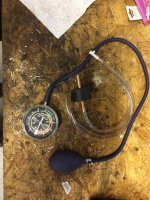1. Ignition System
The installation of an electronic breakerless ignition system is a popular and easily performed modification where the points and condenser inside the distributor are replaced with a pickup coil and electronic control unit. The unit is easily installed in
the stock distributor and once the air gap is established there is nothing to go out of adjustment or wear, and the periodic maintenance of the original points system— resetting of breaker gap and dwell due to wear, cleaning of the points faces, and/or possible condenser failure, etc.—are all things of the past.
Probably the most popular brand used is Pertronix, as it is designed to fit within the stock Lucas distributor and the only external clue to the unit’s presence is that there are two wires running from coil to distributor versus one. Other brands are available: Crane, Mallory--even Lucas had a go at it! Some of these will also fit within the stock Lucas distributor while others require either external control boxes or replacement distributors. Each has its proponents.
The argument against electronic breakerless ignition systems is that while they do not need maintenance their failure mode is often total—one minute they are fine and the next minute they have stopped working and must be replaced. For that reason many owners who install this mod retain the original parts, or a second module, on board “just in case”. Electronic ignitions are sensitive to overheating, which happens if the ignition key is left on without the engine running, but given the same situation breaker points may burn or pit if in contact with each other due to continuous current them. By the way, don’t forget to lubricate the breaker cam!
A distributor is an electromechanical device and subject to wear, so while it may not be 100% bulletproof an electronic ignition module comes about as close as the technology permits and thus makes the list as it increases the odds of having that trouble-free adventure. Conventional wisdom is that an electronic system should last around 25,000 miles whereas a points set will need replacement and/or maintenance within 5000.
When installing electronic distributors many people also replace the stock ignition coil with a “high output” unit, the theory being that these offer higher voltage which the electronic systems can utilize. However, since this modification offers only the hope of better performance versus increased reliability it is outside the scope of this discussion. However, there is another component connected—literally directly connected—to the coil that deserves mention here: the shutoff switch in the boot and the white/black wire that runs from the coil to it.
This switch has two circuits within it and when turned to off the battery ground connection to the frame is broken and at the same time the ignition coil is grounded out. If its intended purpose is to provide a means of theft-proofing sometimes it does its job all too well with no regard as to who is trying to drive the car. The switch is often the source of sudden, mysterious running problems and abrupt stoppages and is roundly condemned as being of poor design and shoddy construction. Because it is riveted together it does not invite easy disassembly though this can be done and the rivets replaced with screws. Nevertheless the internals are subject to wear and corrosion and nothing will result in a call to AAA faster than this switch’s failure.
An easy solution is to remove the switch—either from the car entirely or from the battery ground circuit--replacing the two pieces of wire that ran from the battery through the switch to the grounding point on the frame with one new lead, and tape off the coil end of the white/black wire, but that eliminates the anti-theft protection that the switch offers. Thankfully modern alternatives are available, including ones with removable keys such as the one installed on my 100 manufactured by Hella.

 Hi Guest!
Hi Guest!

 smilie in place of the real @
smilie in place of the real @
 Pretty Please - add it to our Events forum(s) and add to the calendar! >>
Pretty Please - add it to our Events forum(s) and add to the calendar! >> 

